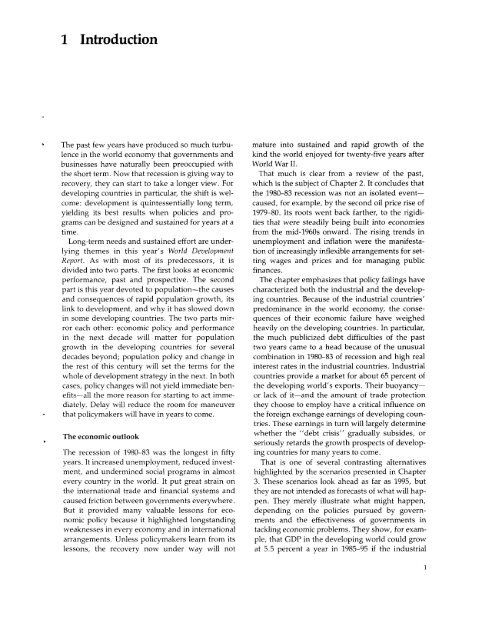World Development Report 1984
World Development Report 1984
World Development Report 1984
You also want an ePaper? Increase the reach of your titles
YUMPU automatically turns print PDFs into web optimized ePapers that Google loves.
1 Introduction<br />
The past few years have produced so much turbu- mature into sustained and rapid growth of the<br />
lence in the world economy that governments and kind the world enjoyed for twenty-five years after<br />
businesses have naturally been preoccupied with <strong>World</strong> War II.<br />
the short term. Now that recession is giving way to That much is clear from a review of the past,<br />
recovery, they can start to take a longer view. For which is the subject of Chapter 2. It concludes that<br />
developing countries in particular, the shift is wel- the 1980-83 recession was not an isolated eventcome:<br />
development is quintessentially long term, caused, for example, by the second oil price rise of<br />
yielding its best results when policies and pro- 1979-80. Its roots went back farther, to the rigidigrams<br />
can be designed and sustained for years at a ties that were steadily being built into economies<br />
time. from the mid-1960s onward. The rising trends in<br />
Long-term needs and sustained effort are under- unemployment and inflation were the manifestalying<br />
themes in this year's <strong>World</strong> <strong>Development</strong> tion of increasingly inflexible arrangements for set-<br />
<strong>Report</strong>. As with most of its predecessors, it is ting wages and prices and for managing public<br />
divided into two parts. The first looks at economic finances.<br />
performance, past and prospective. The second The chapter emphasizes that policy failings have<br />
part is this year devoted to population-the causes characterized both the industrial and the developand<br />
consequences of rapid population growth, its ing countries. Because of the industrial countries'<br />
link to development, and why it has slowed down predominance in the world economy, the consein<br />
some developing countries. The two parts mir- quences of their economic failure have weighed<br />
ror each other: economic policy and performance heavily on the developing countries. In particular,<br />
in the next decade will matter for population the much publicized debt difficulties of the past<br />
growth in the developing countries for several two years came to a head because of the unusual<br />
decades beyond; population policy and change in combination in 1980-83 of recession and high real<br />
the rest of this century will set the terms for the interest rates in the industrial countries. Industrial<br />
whole of development strategy in the next. In both countries provide a market for about 65 percent of<br />
cases, policy changes will not yield immediate ben- the developing world's exports. Their buoyancyefits-all<br />
the more reason for starting to act imme- or lack of it-and the amount of trade protection<br />
diately. Delay will reduce the room for maneuver they choose to employ have a critical influence on<br />
that policymakers will have in years to come. the foreign exchange earnings of developing countries.<br />
These earnings in turn will largely determine<br />
The economic outlook whether the "debt crisis" gradually subsides, or<br />
seriously retards the growth prospects of develop-<br />
The recession of 1980-83 was the longest in fifty ing countries for many years to come.<br />
years. It increased unemployment, reduced invest- That is one of several contrasting alternatives<br />
ment, and undermined social programs in almost highlighted by the scenarios presented in Chapter<br />
every country in the world. It put great strain on 3. These scenarios look ahead as far as 1995, but<br />
the international trade and financial systems and they are not intended as forecasts of what will hapcaused<br />
friction between governments everywhere. pen. They merely illustrate what might happen,<br />
But it provided many valuable lessons for eco- depending on the policies pursued by governnomic<br />
policy because it highlighted longstanding ments and the effectiveness of governments in<br />
weaknesses in every economy and in international tackling economic problems. They show, for examarrangements.<br />
Unless policymakers learn from its ple, that GDP in the developing world could grow<br />
lessons, the recovery now under way will not at 5.5 percent a year in 1985-95 if the industrial<br />
1









